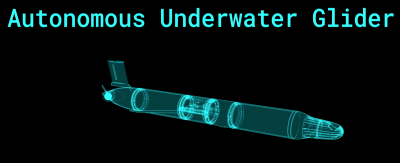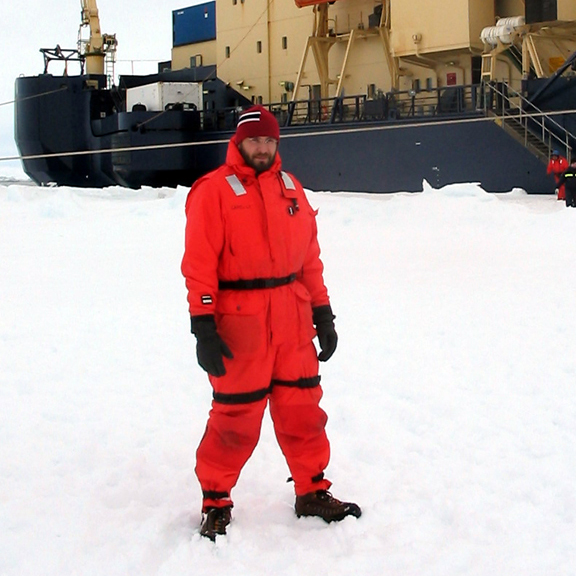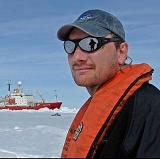Project Abstract
 This project advances the national health, prosperity, and welfare by developing and demonstrating a new robotic technology for persistent, autonomous observation of under-ice marine environments over large (>1000 km) spatial scales. The Arctic is undergoing rapid change, with dramatic shifts in the sea ice cover and upper ocean. Monitoring and understanding these changes is critical to improving our ability to predict ongoing change and variability on seasonal-to-decadal timescales. Current observational capabilities are severely hampered by the logistical challenges of operating in this environment—observations are sparse, infrequent, and expensive to obtain, especially for the under sea-ice observations. As a low-cost, easy to deploy platform, the unmanned underwater vehicle developed by this project will be transformative in our capability for effective, widespread, and continuous monitoring of the Arctic Ocean and its ice cover. Under-ice missions to monitor ice-ocean properties across a retreating ice edge in spring will provide a proof of concept for a unique capability to efficiently address a wide range of scientific questions under the Arctic ice cover that can benefit from measurements over large spatial and temporal scales. This project supports the NSF Big Idea on Navigating the New Arctic. As a future component of an Arctic Observing Network, this innovative technology can provide a critical cog in our ability to effectively monitor the Arctic and inform management of increased Arctic commercial, mineral extraction, and fisheries activities, as well as planning for resilience of Arctic coastal communities.
This project advances the national health, prosperity, and welfare by developing and demonstrating a new robotic technology for persistent, autonomous observation of under-ice marine environments over large (>1000 km) spatial scales. The Arctic is undergoing rapid change, with dramatic shifts in the sea ice cover and upper ocean. Monitoring and understanding these changes is critical to improving our ability to predict ongoing change and variability on seasonal-to-decadal timescales. Current observational capabilities are severely hampered by the logistical challenges of operating in this environment—observations are sparse, infrequent, and expensive to obtain, especially for the under sea-ice observations. As a low-cost, easy to deploy platform, the unmanned underwater vehicle developed by this project will be transformative in our capability for effective, widespread, and continuous monitoring of the Arctic Ocean and its ice cover. Under-ice missions to monitor ice-ocean properties across a retreating ice edge in spring will provide a proof of concept for a unique capability to efficiently address a wide range of scientific questions under the Arctic ice cover that can benefit from measurements over large spatial and temporal scales. This project supports the NSF Big Idea on Navigating the New Arctic. As a future component of an Arctic Observing Network, this innovative technology can provide a critical cog in our ability to effectively monitor the Arctic and inform management of increased Arctic commercial, mineral extraction, and fisheries activities, as well as planning for resilience of Arctic coastal communities.
This project will develop and demonstrate a highly modified autonomous underwater glider (AUG) equipped with a dual-use active sonar for characterizing ice thickness distribution, as well as for real-time terrain-aided navigation. This will enable under-ice observation across extended distances without the need for external navigation aids such as acoustic beacons. The AUG will also encompass an automated mission planner/replanner wherein the vehicle can autonomously adapt its mission plan in response to evolving mission goals and environmental or vehicle state changes, such as data-driven adaptive sampling, changing surfacing locations based on ice drift, or in the event of a component failure impeding vehicle progress and decreasing expected range. Finally, a new variable thrust hybrid propulsion system will be developed for operation in both shallow coastal waters with high currents and deeper waters, enabling efficient transit from coastal to remote science locations, while enabling the vehicle to conduct water column profiling, as well as close-range ice survey. These characteristics will facilitate long-term unattended, under-ice observation with reduced cost and logistical requirements.
Logistics Summary
This NNA collaboration between Camilli (1839063, WHOI) and Williams (1837646, MIT) will develop and demonstrate a new robotic technology for persistent, autonomous observation of under-ice marine environments over large (>1000 km) spatial scales. This new autonomous vehicle technology will be a highly modified hybrid autonomous underwater glider (AUG) with new, efficient propulsion that can operate effectively on both shallow shelves and deeper waters, autonomous terrain aided navigation without the need for external navigation aids, and both ocean profiling and ice survey capability. 2019 will focus on testing the vehicle platform, including launch and recovery systems and extensive sea trials in shallow coastal Massachusetts waters (including in high current areas). In 2020, a field team of two will travel to Alaska for field testing and deployment site selection. These initial Arctic field trials will be carried out over a one-week period using a small research vessel (R/V Ukpik) on the continental shelf and shelf break between Prudhoe Bay and Utqiaġvik (Barrow) Alaska in August. The following year in 2021, a field team of two will conduct continuous under-ice operations in field trials that will investigate the ice-ocean interactions driving ice retreat over four months in the Chukchi Sea.
Season Field Site
2020 Alaska - Prudhoe Bay
2020 Alaska - Utqiaġvik (Barrow)
2021 Arctic Ocean and Seas - Chukchi Sea
Keywords
Hybrid underwater glider, sea ice, upper-ocean, sustained autonomous observations
Project Location
Resources
Dates
-Location
Prudhoe Bay, AK; Utqiaġvik, AK; Arctic Ocean; Chuckchi SeaMembers
Principal Investigator

Principal Investigator

Co-Principal Investigator

Co-Principal Investigator

Co-Principal Investigator

